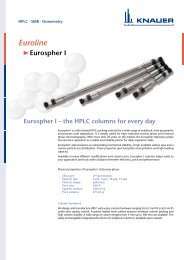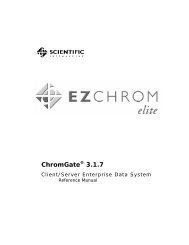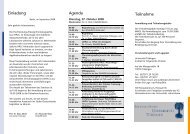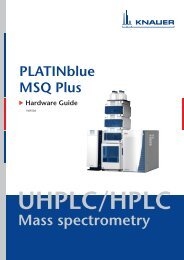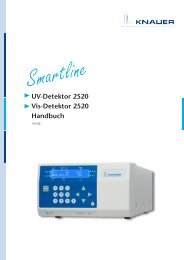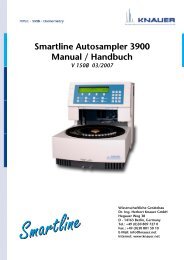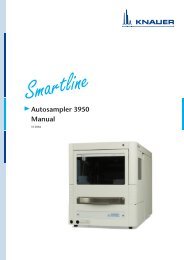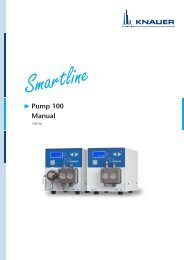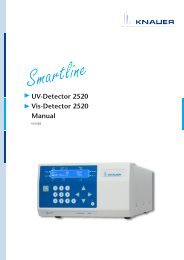ChromeGate 3.3.2 Software Manual - KNAUER Advanced Scientific ...
ChromeGate 3.3.2 Software Manual - KNAUER Advanced Scientific ...
ChromeGate 3.3.2 Software Manual - KNAUER Advanced Scientific ...
You also want an ePaper? Increase the reach of your titles
YUMPU automatically turns print PDFs into web optimized ePapers that Google loves.
PDA Analysis and Calculations 227<br />
Noise Spectrum Calculations<br />
A noise spectrum is used in Purity calculations to compensate for solvent<br />
and detector effects. The spectrum is computed using a 3D data file and<br />
a user-supplied retention time range.<br />
The noise spectrum is an array of data points over the spectrum range.<br />
Each data point in the noise spectrum is 3 standard deviations of the<br />
mean of the absorbance values for that wavelength over the usersupplied<br />
time range of the 3D data.<br />
Peak Purity Calculations<br />
Peak purity calculations use the spectra from 3D PDA data to assess the<br />
purity of a chromatographic peak. Spectra from the peak are compared to<br />
the apex spectrum to compute a measure of uniformity of the spectra.<br />
Background Correction<br />
Background Correction may only be performed on a spectrum as a result<br />
of the settings on the Spectrum tab of PDA Options, the settings on the<br />
Purity tab of PDA Options, or by setting the properties of the Peak<br />
Purity Pane.<br />
Background subtraction is always the first operation performed on a<br />
spectrum. If a background correction is attempted on a spectrum after<br />
another operation has already been performed (including an operation<br />
specified in the Spectrum tab of PDA Options), a message box is<br />
displayed and the background correction request ignored.<br />
Background subtraction may only be performed once on a spectrum. If a<br />
second background correction is attempted on a spectrum after the<br />
operation has already been performed (including the operation specified<br />
in the Spectrum tab of PDA Options), a message box is displayed and<br />
the background correction request ignored.<br />
A background correction is performed as follows:<br />
1. The spectra from the baseline start and baseline stop times for the<br />
peak are extracted from the 3D data. The Max Plot is used to<br />
determine the peak that is used.<br />
2. For each spectrum in the peak, a corresponding background<br />
spectrum is generated by linear interpolation between the baseline<br />
start and baseline stop spectra.<br />
3. These background spectra are subtracted from the original<br />
spectra.<br />
While compensation for background will provide more precise<br />
purity calculations, it can slow down re-analysis of large data files.<br />
Calculating Total Purity<br />
Total purity for an integrated peak is calculated as follows:<br />
1. The purity calculation range of the peak is determined by starting<br />
from the peak apex and working toward peak start and peak end.<br />
Each chromatographic point in the peak is compared to the<br />
absorbance threshold. The start and stop values of the range are<br />
defined as the point at which the absorbance drops below the<br />
absorbance threshold.<br />
2. For each point in the calculation range, a similarity index is<br />
calculated by comparing the spectrum for that point to the peak<br />
apex spectrum.





